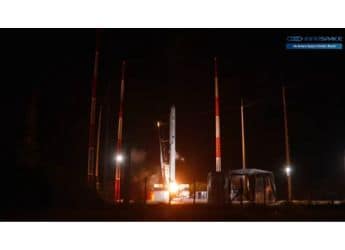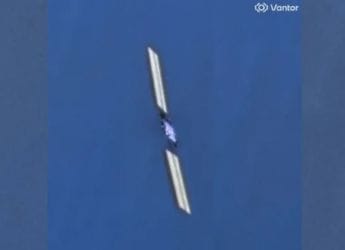- Home
- Science
- Science News
- Universe's Photos Clicked by James Webb Telescope Displayed at Times Square Screens
Universe's Photos Clicked by James Webb Telescope Displayed at Times Square Screens
The James Webb Space Telescope has been designed to capture the faintest of light so that deep secrets of the universe can be revealed.

Some of the images captured by James Webb telescope.
The James Webb Space Telescope offered a never-seen-before glimpse in the deep dark depths of the universe in high-resolution photos released by American space agency NASA this week. It filled the hearts of space enthusiasts with joy and the scientists who created it with hope that the world's most powerful telescope will help them unravel new mysteries of the universe. The $10 billion telescope is able to capture faintest of light, which was reflected in the images released on Monday and Tuesday - of the stars formed 13 billion years ago.
Those images are now on display on the giant screens installed at New York's Times Square. The images have been displayed along with the hashtag #UnfoldTheUniverse and show nebulas, a galactic cluster and possible water vapour on an exoplanet.
The first full-color images from the world's most powerful space telescope @NASAWebb 🔭 are on view at @MorganStanley #UnfoldTheUniverse @NASA 💫✨ pic.twitter.com/M0yjqwrWmO
— Times Square (@TimesSquareNYC) July 12, 2022
Among these images are the "dying star's final dance", which American space agency NASA said shows a star sending out rings of gas and dust in all directions. This phenomenon takes place for thousands of years and has been captured by the James Webb Space Telescope for the first time showing the star cloaked in dust.
NASA's James Webb Space Telescope image reveal in Times Square pic.twitter.com/zXBFuh3JqM
— Khola (@kholashafqat) July 13, 2022
The first image unveiled on Monday showed the galaxy cluster SMACS 0723. The second set of images released by American space agency NASA showed Carina Nebula, WASP-96 b (spectrum data), Southern Ring Nebula and Stephen's Quintet.
Located 7,600 light-years away, the Carina Nebula is a stellar nursery, where stars are born. It is one of the largest and brightest nebulae in the sky and home to many stars much more massive than our sun, CNN reported.
The Southern Ring Nebula, also called the "Eight-Burst," is 2,000 light-years away from Earth. This large planetary nebula includes an expanding cloud of gas around a dying star.
The James Webb Space Telescope is an international collaboration among NASA, the European Space Agency (ESA), and the Canadian Space Agency (CSA). It has been specially tuned to see the sky in the infrared - that's light at longer wavelengths than can be sensed by our eyes.
Get your daily dose of tech news, reviews, and insights, in under 80 characters on Gadgets 360 Turbo. Connect with fellow tech lovers on our Forum. Follow us on X, Facebook, WhatsApp, Threads and Google News for instant updates. Catch all the action on our YouTube channel.
Related Stories
- Samsung Galaxy Unpacked 2025
- ChatGPT
- Redmi Note 14 Pro+
- iPhone 16
- Apple Vision Pro
- Oneplus 12
- OnePlus Nord CE 3 Lite 5G
- iPhone 13
- Xiaomi 14 Pro
- Oppo Find N3
- Tecno Spark Go (2023)
- Realme V30
- Best Phones Under 25000
- Samsung Galaxy S24 Series
- Cryptocurrency
- iQoo 12
- Samsung Galaxy S24 Ultra
- Giottus
- Samsung Galaxy Z Flip 5
- Apple 'Scary Fast'
- Housefull 5
- GoPro Hero 12 Black Review
- Invincible Season 2
- JioGlass
- HD Ready TV
- Laptop Under 50000
- Smartwatch Under 10000
- Latest Mobile Phones
- Compare Phones
- Huawei Nova 15
- Huawei Nova 15 Pro
- Huawei Nova 15 Ultra
- OnePlus 15R
- Realme Narzo 90x 5G
- Realme Narzo 90 5G
- Vivo S50 Pro Mini
- Vivo S50
- Asus ProArt P16
- MacBook Pro 14-inch (M5, 2025)
- Huawei MatePad 11.5 (2026)
- OnePlus Pad Go 2 (5G)
- Huawei Watch 10th Anniversary Edition
- OnePlus Watch Lite
- Acerpure Nitro Z Series 100-inch QLED TV
- Samsung 43 Inch LED Ultra HD (4K) Smart TV (UA43UE81AFULXL)
- Asus ROG Ally
- Nintendo Switch Lite
- Haier 1.6 Ton 5 Star Inverter Split AC (HSU19G-MZAID5BN-INV)
- Haier 1.6 Ton 5 Star Inverter Split AC (HSU19G-MZAIM5BN-INV)

















